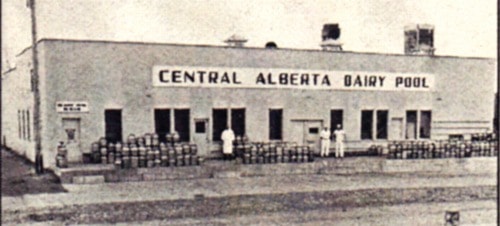From the beginning of time, there has always been a most vital presence of milk in various forms and from many sources throughout the world, but Canada’s now ultra-modern and highly sophisticated multi-billion dollar dairy and processing industry most likely had its humble beginnings in the early 1600s. It was then that French settlers introduced dairy cattle into our nation, which would rapidly grow into a massive farm and cottage operation that flourished for over 250 years in all provinces. By 1873, there were 200 cheese factories in Canada, in 1883 the price of milk was set at 2.5 to 4 cents a quart, the first milk bottles appeared in 1884, the first big steel milk tankers hit the rough country roads in 1914, mandatory pasteurization began in 1917, and by 1961, there were 1710 dairies in operation in all corners of our nation.
The creameries of Ponoka and district
In the very early 1900s, settlers from Canada and the United States as well as overseas were moving into this district in great numbers, most of whom were only able to bring along their most precious belongings, along with a few horses and cows. As they established their farms and built their new homes and businesses in and around Ponoka, the need for supplies, especially livestock and milk products was crucial not only to feed the ever-growing families, but also to rely on for revenue and trading to assure their daily existence as well as establish a bright future.
In those early days, absolutely everyone, including adults and children, had to become very good at the many day-to-day chores such as collecting eggs, as well as chasing the elusive cows and milking them by hand early in the morning, rain or shine. Before cream separators came on the scene, the milk was put into huge upright tanks and cold water was carefully added to bring the cream to the top. Most farms in the Ponoka area were of the mixed variety, which included horses, cattle, pigs, ducks, geese, chickens, turkeys, sheep, a big garden and at least six to 12 milk cows, all to help pay the bills and keep their busy operations going and growing smoothly through the seasons and from seeding to harvests.
As the demand increased for dairy products such as fluid milk, cream, butter and cheese throughout the province and supplies became very low, the industry would set up gathering depots in many areas to collect the many by-products of the ‘white liquid gold’ that originated from down on the farm. The first gentlemen in our community to manage these vital terminals were led by Bob German, and included Mr. Peck, Bill Bachor and Mr. Bednar as the early managers who oversaw the arrival and shipping of 400 gallons of cream a week. The hardy farmers, of course, had to load up their horse drawn wagons and later noisy old trucks to battle through all sorts of road and weather conditions to get the precious products of their hard work into town each and every day. Ponoka’s first creamery was built in 1904 and operated by W.A. Brodie in the area which later became the Canada Packer’s Feed Mill. The White Rose Creamery served the surrounding districts for many years, and was later purchased by a Mr. Barrett, a big and jovial Englishman who loved to sing. Unfortunately, the building burnt down in 1916, and it was not until 1921 that a group of local farmers put up the money to build a new sturdy masonry creamery in the area now just across from the Alternate School, which they leased to the Burn’s Company to operate.
In 1922, the Fertile Valley Creamery was started by local entrepreneurs and shareholders Anton Lux, Jack Few, Bill Bachor, Bruce Stephens and Angus MacLeod, with this very successful local plant quickly expanding to collect cream and poultry from as far away Innisfail, Bluffton, Millet, Erskine and New Norway. Swift Canadian Company Ltd. would purchase the facility from Angus MacLeod and Jack Van Dyke in 1928, with new managers including D.C. Brown, Bob Wotherspoon, Butter maker Bill Bailey, Cream Graders Moe Linneboe and Val Taylor and on and on. Their keen reputation of dedication and great service was echoed around the districts for decades as they faithfully picked up the products from the farmer, cashed their cream-cheques and quite often did many extras such as delivering their groceries or other supplies from town.
The Central Alberta Dairy Pool bought the Ponoka-based building in 1943 from Burns, and immediately began the first friendly service of delivering pasteurized milk throughout the community door to door for tokens. The CADP became the largest operation of its kind by the early 1950s, and along with the longstanding Fertile Valley Creamery, became as vital to the dairy farmers as the elevators were to the grain farmers. Some the many managers over the years at the CADP plant were Toni Severson, Norman Pallison, Eddy Pederson, Jack Neale, Carl Christensen and George Heronemus, and over the years the skills of their staff and the excellent quality of their products would win countless awards and honours at fairs and competitions across the nation.
The increasing operating costs of these small local facilities, outdated equipment and a potentially costly conversion to metric sadly led to the closure of the popular Central Alberta Dairy Pool creamery in 1979, followed by the eventual demolition in 1989. Although countless changes and the additions of modern new equipment and processing facilities have occurred over the years, the wide-ranging dairy industry can always be very proud of their long-standing tradition of quality products and service, offered every day, all the way from the farm to the plant and into our stores and homes.
